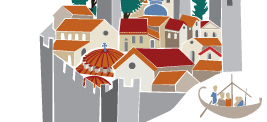Warfare
During
the period of Byzantine
Empire, various nations wanted to occupy
its territories. Trying to organize the defence, the Byzantine cities were the
basis of the political, military and ecclesiastical administration and for that
reason, their fortification was a major goal of the imperial administration.
According
to the work of Procopius “Peri Ktismatwn” About
buildings, Justinian
“Peri Ktismatwn” About
buildings, Justinian trying to strengthen the defence of the state, he
granted money in order to rebuild the walls of many under ordinate towns, and
in order to create or strengthen with fortifications the strategic places of
special importance. At the same time, he organized a network of new fortified
cities in vital places in order to ensure the protection of the streets and the
trade routes. The fortification practice
was not unknown in the ancient world, however in the Byzantine era, it was
developed a lot, with many and impressive examples in the whole empire.
Fortified cities, citadels, castles, towers, intermediate walls, were created for
the defense of the state and ensured the protection the residents.
trying to strengthen the defence of the state, he
granted money in order to rebuild the walls of many under ordinate towns, and
in order to create or strengthen with fortifications the strategic places of
special importance. At the same time, he organized a network of new fortified
cities in vital places in order to ensure the protection of the streets and the
trade routes. The fortification practice
was not unknown in the ancient world, however in the Byzantine era, it was
developed a lot, with many and impressive examples in the whole empire.
Fortified cities, citadels, castles, towers, intermediate walls, were created for
the defense of the state and ensured the protection the residents.
Although
the emperor and the supreme dignitaries emphasized mainly on the diplomacy for
the confrontation of the hostile disposals of the neighbors, the organization
of the army and navy became an urgent requirement. The organization of the army
was based on two corps: limitanei and comitanses. Limitanei were farmers lived
in the borders, to which the state granted cultivable ground with the obligation
to offer military services. Comitanses were the regular army, under the
leadership of the the emperor, who could be transported wherever it was
required. Other corps were the allies, the bucellarii and the
confederates, that consisted of foreigner condotieres.
However,
the Byzantine army, despite the well organization, it could not be a ready for
war and effective as a mass, capable of ensuring the integrity of the
territories of the Byzantine empire and the safety of the residents, if they
were not equipped with the right
military equipment (armor and helmet) and arms. The polemic arms are
distinguished between those of fighting hand to hand (sword, lance, club, axe,
arcs and arrows) that were used for fighting body to body, and of ballistic arms
that struck the enemy from distance. Of this last type were the wall fighting
arms, meaning all those which were used during the sieges of castles, such as
the battering ram, the pelting, and the tortoise (chelone). Apart from the army of land, the navy was
particularly organized too in Byzantium, as an organic department of the administration
of themata (provinces).So, the fleet of the provinces was created, the thematic
ploima (watercrafts of provinces), with head generals or drungaries. The Royal
water craft was an independent fleet for the defense of the capital with head
the drungarios
(provinces).So, the fleet of the provinces was created, the thematic
ploima (watercrafts of provinces), with head generals or drungaries. The Royal
water craft was an independent fleet for the defense of the capital with head
the drungarios , that had the role of the general admiral.
, that had the role of the general admiral.
The
Byzantine navy allocated dromons, dromonia and chelandia that were boats
equipped, on one hand, with wooden castles “xylokastra”, from where the
warriors could throw missiles against the hostile boats, and on the other hand,
with throwing machines for “sifones”, the earthen or metal containers that
contained the Greek fire. Greek fire was the most perfected version of between
now and then known incendiary materials on martial purposes. The main success of
it, at the naval battles, was that it caused the confusion and the panic in any
hostile fleet, which was forced to leave because of the fire and the bad effect
on the moral of the crew of the wooden ships.
Bibliography (0)▼
Comments (0)▼
New Comment▼








